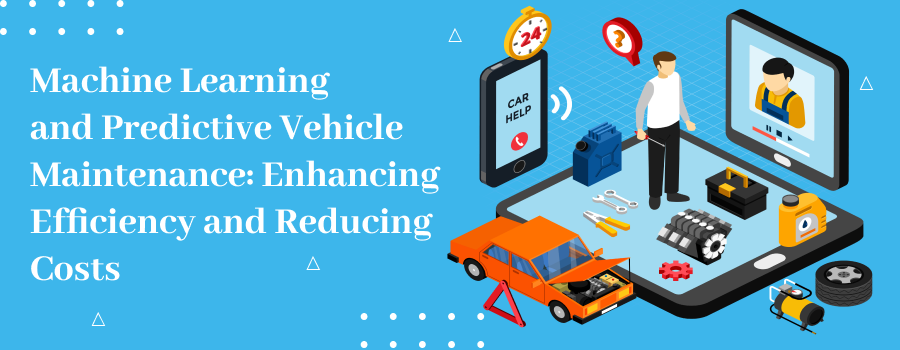Posted on: Dec 9, 2024
Estimated reading time: 0 minutes
Machine Learning and Predictive Vehicle Maintenance: Enhancing Efficiency and Reducing Costs.

Predictive Vehicle Maintenance and Machine Learning's Role
Vehicles are necessary for both personal and professional transportation in the fast-paced world of today. Making sure that cars run smoothly is essential to preventing expensive malfunctions and downtime, whether for daily commuting or fleet management. Because traditional maintenance schedules are frequently based on set intervals, they may result in needless repairs or fail to notice warning indications of upcoming problems.
Predictive vehicle maintenance, a more proactive and effective solution, is being offered by machine learning, which is altering the way that vehicle maintenance is done.
What is predictive vehicle maintenance?
A method called predictive vehicle maintenance (PVM) makes use of cutting-edge technologies, such as sensors and data analytics, to forecast when a car will need maintenance. Predictive maintenance uses information from multiple sensors and past performance records to foresee possible failures before they occur, in contrast to traditional maintenance, which frequently depends on planned intervals regardless of the vehicle's actual condition.
A key component of this process is machine learning, which analyzes vast amounts of data to find trends and forecast when a car may break down or require maintenance. This strategy lowers expenses and improves operational efficiency for both individuals and companies managing their fleets of vehicles.
How Predictive Maintenance Is Powered by Machine Learning
Machine learning algorithms analyze vast amounts of data gathered from vehicles' onboard diagnostic systems. This data covers a variety of topics, such as brake conditions, fuel efficiency, tire pressure, and engine performance. Machine learning systems are able to recognize irregularities, early wear and tear indicators, and potential component failure dates by continuously learning from this data.
Cost Savings and Enhanced Efficiency: By avoiding needless maintenance and reducing downtime, predictive maintenance lowers costs. The risk of overservicing is decreased, and operating expenses are decreased, by performing maintenance only when required rather than replacing parts at predetermined intervals. Additionally, vehicles are only taken offline when absolutely necessary thanks to the ability to schedule maintenance around predictive data.
Increased Vehicle Longevity: Predictive maintenance helps prolong the life of vehicles by attending to maintenance requirements before they become serious problems. By avoiding significant breakdowns and maintaining the condition of vital parts, prompt repairs and maintenance guarantee that automobiles are performing at their peak.
Predictive analysis and pattern recognition: Machine learning models utilize this data to find trends and connections between vehicle failures and performance.
For example, the system can forecast that tire replacement or repair is probably needed soon if a sensor shows that a car's tire pressure is continuously lower than usual. Over time, the system's predictions get more accurate the more data it gathers.
Sensors and Data Collection: A range of sensors found in contemporary cars gather data in real time, including tire pressure, fuel consumption, engine temperature, and more. The performance of the vehicle is then continuously monitored by machine learning algorithms using this data.
Real-Time Alerts: As machine learning algorithms analyze the data, they can notify fleet managers or car owners in real-time of possible problems.
For example, the system can send a maintenance alert if it determines a part is approaching the end of its useful life, enabling preventative repairs before a breakdown happens.
Predictive Vehicle Maintenance Benefits of Machine Learning
Fleet managers can make better decisions based on real-time, data-driven insights by utilizing machine learning. Managers can evaluate each vehicle's condition and allocate resources appropriately, resulting in cost savings and improved fleet management, rather than depending on hunches or antiquated maintenance schedules.
Long-Term Savings: Although putting predictive maintenance systems in place may be expensive up front, there will be substantial long-term savings. Predictive maintenance lessens the need for pricey emergency services and helps prevent expensive repairs from unplanned malfunctions. The initial cost of the technology may eventually be surpassed by the savings.
Reduced Downtime: One of predictive maintenance's main advantages is a decrease in vehicle downtime. Vehicles spend less time out of service because maintenance can be planned before issues worsen, which is particularly crucial for fleet management. This guarantees that companies can minimize interruptions and preserve operational efficiency.
Safety is also enhanced by predictive maintenance, which identifies possible risks before they become serious.
Predicting when tires or brake pads need to be replaced, for example, can help avoid accidents brought on by malfunctioning equipment. Both private drivers and drivers of commercial fleets benefit from safer driving conditions as a result.
Applications of Machine Learning in the Real World for Auto Repair
Predictive maintenance powered by machine learning has already started to be implemented by numerous businesses and sectors for their fleets of vehicles. Predictive maintenance, for example, is used by Uber and Lyft to maximize the efficiency and security of their cars. Machine learning algorithms are also used by major fleet operators, such as delivery services and public transportation systems, to monitor vehicle performance and guarantee on-time maintenance.
In order to improve the customer experience by providing cutting-edge features like early failure alerts and maintenance reminders, automakers such as General Motors and BMW are incorporating predictive maintenance into their vehicle models.
Machine Learning's Role in Predictive Auto Maintenance
The use of machine learning technology in predictive vehicle maintenance will only grow as it develops further. More complex models that incorporate other data sources, like traffic patterns and weather conditions, might be developed in the future to produce predictions that are even more precise. Additionally, the combination of machine learning and autonomous vehicles may allow for completely automated repair and maintenance scheduling, greatly simplifying vehicle maintenance.
Conclusion
Vehicle maintenance is being transformed by machine learning, which makes it more proactive, predictive, and effective. Businesses and individuals can save time, money, and effort by using machine learning algorithms that use data to predict vehicle failures before they happen. Predictive maintenance will become more crucial as technology develops to guarantee that automobiles continue to be dependable, secure, and reasonably priced for many years to come.